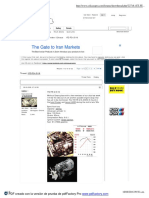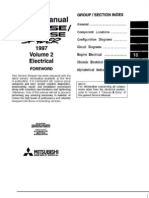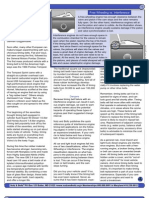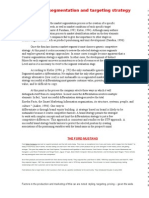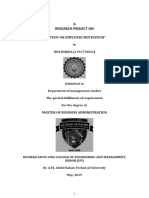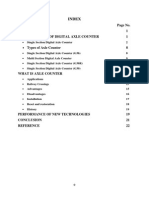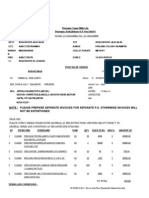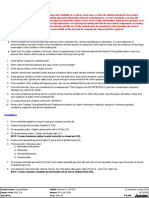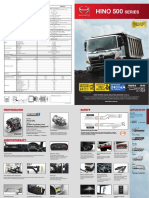CVCC
CVCC
Uploaded by
Prabhat SharmaCopyright:
Available Formats
CVCC
CVCC
Uploaded by
Prabhat SharmaOriginal Description:
Copyright
Available Formats
Share this document
Did you find this document useful?
Is this content inappropriate?
Copyright:
Available Formats
CVCC
CVCC
Uploaded by
Prabhat SharmaCopyright:
Available Formats
1
1.Introduction
CVCC can also be used to represent a consonant-vowel-consonant-
consonant syllable pattern. This article incorporates information from the equivalent
article on the Japanese Wikipedia.
A CVCC engine for Honda Civic
CVCC is a trademark by the Honda Motor Company for an engine with
reduced automotive emissions, which stood for "Compound Vortex Controlled
Combustion".
[1]
The first mention of Honda developed CVCC technology was done
by Mr. Soichiro HondaFebruary 12, 1971, at the Federation of Economic
Organizations Hall in Otemachi, Chiyoda-ku, Tokyo.
[2]
Honda's engineers at the time,
Mr. Date conferred with Mr. Yagi and Mr. Nakagawa about the possibility of creating
lean combustion via a prechamber, which some diesel engines utilized.
[3]
The first
engine to be installed with the CVCC approach for testing was the single-cylinder,
300 ccHonda EA engine used in the Honda N600 hatchback in January 1970.
[3]
This
technology allowed Honda's cars to meet Japaneseand United States emission
standards in the 1970s without a catalytic converter. A type of stratified charge
engine, it first appeared on the 1975 ED1 engine. As emission laws advanced and
required more stringent admissible levels, Honda abandoned the CVCC method and
introduced PGM-FI, or Programmed Fuel Injection on all Honda vehicles. Some
vehicles in Japan had a combination of electronically controlled carburetors, called
PGM-Carb on specific, transitional Honda D, E and ZC engines.
Toyota briefly used a similar technology in the mid-to-late seventies, called TTC-V.
In 2007, the Honda CVCC technology was added to the Mechanical Engineering
Heritage of Japan.
2
2. CONSTRUCTION AND OPERATION
Honda CVCC engines have normal inlet and exhaust valves, plus a small auxiliary
inlet valve which provides a relatively rich airfuel mixture to a volume near
the spark plug. The remaining airfuel charge, drawn into the cylinder through the
main inlet valve, is leaner than normal. The volume near the spark plug is contained
by a small perforated metal plate. Upon ignition flame fronts emerge from the
perforations and ignite the remainder of the airfuel charge. The remaining engine
cycle is as per a standard four-stroke engine.
This combination of a rich mixture near the spark plug, and a lean mixture in the
cylinder allowed stable running, yet complete combustion of fuel, thus reducing CO
(carbon monoxide) and hydrocarbon emissions. This method allowed the engine to
burn less fuel more efficiently without the use of an exhaust gas recirculation valve or
a catalytic converter, although those methods were installed later to further improve
emission reduction.
3. ADVANTAGES OVER PREVIOUS STRATIFIED
CHARGE ENGINES
Honda's big advancement with CVCC was that they were able to use carburetors and
they did not rely on intake swirl. Previous versions of stratified charge engines needed
costlyfuel injection systems. Additionally, previous engines tried to increase the
velocity and swirl of the intake charge in keeping the rich and lean mixtures
separated. Honda was able to keep the charges adequately separated by combustion
chamber shape.
4. EARLY DESIGN FLAW
Some of the early CVCC engines had a problem with the auxiliary valves retaining
collars vibrating loose. Once unscrewed, engine oil would leak from the valvetrain
into the pre-combustion chamber, causing a sudden loss of power and massive
amounts of smoke to emanate from the exhaust pipe. The condition simulated a blown
engine, even though the needed repair was quite simple. Honda eventually came up
with a fix involving metal retaining rings that slipped over the collars and prevented
them from backing out of their threads.
3
5. CVCC-II
The 1983 Honda Prelude (the first year of the second generation of Preludes) used a
CVCC design and a catalytic converter to reduce emissions, called CVCC-II, along
with 2 separate sidedraught carburettors (instead of a single progressive twin choke
carburettor). The following year a standard cylinder head design was used and the
center carburettor (providing the rich mixture) was dropped. The Honda City AA,
introduced in November 1981, also used a CVCC-II engine called the ER.
6. LIST OF CVCC EQUIPPED ENGINES
ED
The ED series introduced the CVCC technology. This group displaced 1,487 cc
(1.487 L; 90.7 cu in) and used an SOHC 12-valve design. Output with a 3
barrel carburetor was 52 hp (39 kW) @ 5000 rpm and 68 lb ft (92 N m) @ 3000 rpm.
ED1
1975- Honda Civic CVCC
ED2
1975- Honda Civic Wagon
ED3
1976-1979 Honda Civic CVCC
ED4
1976-1979 Honda Civic Wagon
EF
The EF was an SOHC 12-valve (CVCC) engine, displacing 1.6 L (1598 cc). Output
was 68 hp (51 kW) @ 5000 rpm and 85 lb ft (115 N m) @ 3000 rpm.
74 mm bore x 93 mm stroke
Cast iron block & aluminum cylinder head
Six port cylinder head (4 intake port / 2 exhaust ports)
Valve order (IEEIIEEI)
Three barrel Keihin carburettor (1976 had manual choke, 1977 & 1978 were
automatic choke)
Point type ignition
USAGE: 1976-1978 Honda Accord CVCC, US market automobiles.
[5]
EJ
4
The EJ displaced 1,335 cc (1.335 L; 81.5 cu in) and was an SOHC 12-valve CVCC
engine with a 3 barrel carburetor. 4 intake valves, 4 exhaust valves, and 4 auxiliary
valves. Output was 68 hp (51 kW) @ 5000 rpm and 77 lb ft (104 N m) @ 3000 rpm.
EJ1
1980- Honda Civic, Honda Ballade
1981-1983 Honda Civic CVCC
EK
The EK was an SOHC 12-valve (CVCC) engine, displacing 1.8 L (1,751 cc). Output
varied (see below) as the engine itself was refined.
77 mm bore x 94 mm stroke
Cast iron block & aluminum cylinder head
Three barrel Keihin carburettor (all were automatic choke)
Electronic ignition
Oil cooler (or provision for this in the block)
Cylinder head iterations:
Six port cylinder head (4 intake port / 2 exhaust ports) & IEEIIEEI valve
order for 1979 & 1980 49 state
Eight Port cylinder head (4 intake port / 4 exhaust ports) & IEEIIEEI
valve order for 1980 (California only) and 1981 (50 states)
Eight Port cylinder head (4 intake port / 4 exhaust ports) & EIEIIEIE
valve order from 1982 to end of CVCC production (1985)
Power: 6-port output was 72 hp (54 kW) at 4,500 rpm and 94 lb ft (127 N m)
at 3,000 rpm, while the original 8-port head raised this to 75 hp (56 kW) at
4,500 rpm and 96 lb ft (130 N m) at 3,000 rpm. The revised 4-port (82 &
later) had another slight horsepower increase.
USAGE:
1979-1983 Honda Accord CVCC (US market)
1979-1982 Honda Prelude CVCC (US market)
1981-1985 Honda Vigor (JDM)
EK9 is not related to the EK engine - EK9 is simply the chassis code for 1996-2000
Honda Civic Hatchbacks.
EM
5
The EM displaced 1,487 cc (1.487 L; 90.7 cu in) and was an SOHC 12-valve CVCC
engine. Early versions produced 52 hp (39 kW) @ 5000 rpm and 68 lb ft (92 Nm) @
3000 rpm, while later ones upped the output to 63 hp (47 kW) @ 5000 rpm and
77 lb ft (104 N m) @ 3000 rpm. All used a 3 barrel carburetor.
EM1
1980 Honda Civic, 52 hp (39 kW)
1981-1983 Honda Civic, 63 hp (47 kW)
EP
The EP displaced 1,601 cc (1.601 L; 97.7 cu in) and was an SOHC 8-valve engine
with a 2 barrel carburetor. Output was 90 ps (66 kW) @ 5500 rpm and 13.2 kg m
(129 N m) @ 3500 rpm.
EP
1980-1985 Honda Quintet / Quint (Japan)
1980-1981 Honda Accord
ER
The long-stroke, 12-valve CVCC-II for Japan and 8-valve for Europe and
Asia ER four-cylinder engine was only used in the AA/VF/FA
series City/Jazz (198186).
[4][6]
It was available as a normally aspirated carburated
version or with Honda's own PGM-FI fuel injection as one of a very few turbocharged
engines built by Honda. The Japanese market CVCC engine was also known as
COMBAX, an acronym of COMpact Blazing-combustion AXiom. The E-series were
tuned for economy, with higher gearing and later on with computer controlled
variable lean burn. As of March 1985, the naturally aspirated ER engines gained
composite conrods (a world first in a production car), lighter and stronger these
helped further reduce fuel consumption.
The lower powered engines in the commercial "Pro" series had a lower compression,
a mechanically timed ignition rather than the breakerless setup found in the passenger
cars, and a manual choke. The ER had five crankshaft bearings and the overhead
camshaft was driven by a cogged belt.
Engine type Inline four, SOHC CVCC-II 12-valve
[7][8]
Displacement 1,231 cc (75.1 cu in)
Bore x stroke 66.0 x 90.0 mm
6
Fuel type Leaded (export) or unleaded (domestic)
power torque fuel feed compression notes
33 kW
(45 PS) DIN
at 4500 rpm
82 N m
(60 ft lb)
at
2500 rpm
1 bbl carburetor
10,2:1
(normal)
European
market
41 kW
(56 PS) DIN
at 5000 rpm
93 N m
(69 ft lb)
at
3500 rpm
1 bbl carburetor,
manual choke
10,2:1
(super)
European
market
(ER1 &
ER4
engine)
61 PS
(45 kW) JIS
at 5000 rpm
9.8 kg m
(96 N m;
71 lb ft)
at
3000 rpm
2 bbl carburetor
9,0:1
(unleaded)
Pro T,
Pro F
63 PS
(46 kW) JIS
at 5000 rpm
10.0 kg m
(98 N m;
72 lb ft)
at
3000 rpm
2 bbl carburetor
10,0:1
(unleaded)
E-series,
U, R
(AT),
Cabriolet
(AT)
67 PS
(49 kW) JIS
at 5000 rpm
10.0 kg m
(98 N m;
72 lb ft)
at
3500 rpm
2 bbl carburetor
10,0:1
(unleaded)
R and
Cabriolet
with MT
100 PS
(74 kW) JIS
at 5500 rpm
15.0 kg m
(147 N m;
108 lb ft)
at
3000 rpm
FI, turbo
7,5:1
(unleaded)
City
Turbo
7
110 PS
(81 kW) JIS
at 5500 rpm
16.3 kg m
(160 N m;
118 lb ft)
at
3000 rpm
FI, turbo + intercooler
7,6:1
(unleaded)
[9]
Turbo II
"Bulldog"
Carburetor versions used either a single or 2bbl downdraft Keihin. The turbocharger
in the Turbo and Turbo II was developed together with IHI, the Turbo II being
equipped with an intercooler and a computer controlled wastegate.
ER1-4
ES
The ES displaced 1,829 cc (1.829 L; 111.6 cu in). All ES engines were SOHC 12-
valve engines. The ES1 used dual sidedraft carburetors to produce 100 hp (75 kW) @
5500 rpm and 104 lb ft (141 N m) @ 4000 rpm. The ES2 replaced this with a
standard 3 barrel carburetor for 86 hp (64 kW) @ 5800 rpm and 99 lb ft (134 N m) @
3500 rpm. Finally, the ES3 used PGM-FI for 101 hp (75 kW) @ 5800 rpm and
108 lb ft (146 N m) @ 2500 rpm.
ES1
1983-1984 Honda Prelude
ES2
1984-1985 Honda Accord
ES3
1985- Honda Accord SE-i
1981-1985 Honda Vigor VTL-i, VT-i, TT-i (Japan)
EV
The EV displaced 1,342 cc (1.342 L; 81.9 cu in) and was an SOHC 12-valve design. 3
barrel carburetors produced 60 hp (45 kW) at 5,500 rpm and 73 lb ft (99 N m) at
3,500 rpm for the US market. The JDM version, featuring 12 valves and auxiliary
CVCC valves, produced 80 PS (59 kW) at 6,000 rpm and 11.3 kg m (111 N m) at
3,500 rpm. It was available in all bodystyles of the third generation Honda Civic.
EV1
1983-1986 Honda Civic
1983-1986 Honda CRX
EV2
8
1984-1990 Rover 213 (70 hp)
EW
The final E-family engine was the EW, presented along with the all new third
generation Honda Civic in September 1983. Displacing 1,488 cc (1.5 L; 90.8 cu in),
the EWs were SOHC 12-valve engines. Early 3 barrel EW1s produced from 58 to
76 hp (43 to 57 kW) and 108 to 114 N m (79.7 to 84.1 lb ft). The fuel injected EW3
and EW4 produced 91 hp (68 kW) at 5,500 rpm and 126 N m (92.9 lb ft) at
4,500 rpm. The "EW" name was replaced by the Honda D15 series, with the EW (1,
2, 3, 4, and 5) renamed to D15A (1, 2, 3, 4, and 5) in 1987. It also received a new
engine stamp placement on the front of the engine like the "modern D series"
(1988+).
EW1
1983-1985 Honda Civic/CRX DX (unlabeled)
1983-1986 Honda Civic
1983-1986 Honda Shuttle
EW2
1983-1987 Honda Civic non-CVCC EFI (CDM)
EW3
1985- Honda Civic/CRX Si non-CVCC
EW4
1985-1986 Honda CRX Si non-CVCC
1986 Honda Civic Si non-CVCC
EW5
similar to the EW1, Fuel injected CVCC 12Valve 4 Aux valves. A third
throttle plate in the throttle body supplied intake air to a 5th injector
which powered the CVCC ports, The rated power is different between the
Civic and the CR-X: the Civic makes 100 PS (74 kW) at 5,800 rpm and
13.2 kg m (95.5 lb ft) torque at 4,000 rpm, the CR-X made 110 PS
(108 hp) at 5,800 rpm and 13.8 kg m (99.8 lb ft) torque at 4,500 rpm.
Differences in power are largely down to a more efficient exhaust system
on the CR-X it used a factory cast iron 4-2-1 extractor went through a
catalytic converter further down the exhaust system and had twin exit tail
pipes. The Civic had a short 4-1 design into a catalytic converter and
single pipe exit. There was a revised intake manifold for vehicles
9
produced in 1986 and 1987. The EW5 was only available in Japan. It
came in the following models: CR-X 1.5i, Civic 25i Hatchback, Ballade
CRi Sedan.
EY
EY (1,598cc:80.0X79.5) 94PS/5,800rpm 13.6 kg m/3,500rpm
Engine manufacturer Honda Engine code EY Number of cylinders Straight 4
Capacity 1.6 litre 1598 cc (97.516 cu in) Bore Stroke 80 79.5 mm 3.15 3.13 in
Bore/stroke ratio 1.01 Valve gear SOHC 3 valves per cylinder 12 Total valves
Used in 1983 Honda Accord 1600 E-AC (all trim levels)
7. HONDA CIVIC (FIRST GENERATION)
The first generation Honda Civic is an automobile which was produced
by Honda in Japan from 1973 to 1979.
8. MODEL YEAR CHANGES
Honda began selling the 1169 cc (70 in) transversely mounted inline-four
engine Civic for about US$2,200. The Civic was largely developed as a new platform,
and was the result of taking the previous Honda N600 and increasing the length,
width, height, and wheelbase. The engine displacement was almost double the
previous N600 (599 cc) at 1,170 cc, with two more cylinders added. The car produced
roughly 50 hp (37 kW) and included power front disc brakes, vinyl seating, reclining
bucket seats, and a woodgrain-accented dashboard which has many similarities to the
later Rover SD1. The hatchback version added a fold-down rear seat, an AM radio,
and cloth upholstery. The car had front and rear independent suspension. A four-
speed manual transmission was standard. Options for the Civic were kept to a
minimum, consisting of air conditioning, an automatic transmissioncalled
the Hondamatic, radial tires, and a rear wiper for the hatchback. The car could achieve
40 mpg-US (5.9 L/100 km; 48 mpg-imp) on the highway, and with a small 86.6-inch
(2,200 mm) wheelbase and 139.8-inch (3,550 mm) overall length, the vehicle
weighed 1,500 pounds (680 kg).
The four-door sedan version of this bodystyle was not available in the USA and the
five-door hatchback did not appear until 1978, just before the introduction of the
second generation. In the USA, the advertising campaign used to introduce the Civic
10
was, "Honda, we make it simple." The tagline was later used with other Honda motor
vehicles until the 1984 model year when the company revamped its product lineup.
The Civic's smaller size allowed it to outperform American competitors such as
the Chevrolet Vega and Ford Pinto. When the1973 oil crisis struck, automobile buyers
turned to economy cars. Good fuel mileage benefited the standing of the Honda Civic
in the lucrative U.S. market.
For 1974, the Civic's engine size grew slightly, to 1237 cc and power went up to
52 hp (39 kW). In order to meet the new North American 5 mph (8 km/h) bumper
impact standard, the Civic's bumpers grew 7.1 inches (18 cm), increasing overall
length to 146.9 inches (373 cm).
[1]
The CVCC (Compound Vortex Controlled
Combustion) engine debuted in 1975 and was offered alongside the standard Civic
engine. The optional 53 hp (40 kW) CVCC engine displaced 1488 cc and had a head
design that promoted cleaner, more efficient combustion. The CVCC design
eliminated the need for catalytic converters or unleaded fuel to meet changing
emissions standards, unlike nearly every other U.S. market car. Due to California's
stricter emissions standards, only the CVCC powered Civic was available in that state.
This created a sales advantage in Honda's favor in that CVCC equipped Honda
products afforded the buyer the ability to choose any type of fuel the buyer wanted,
and due to emissions equipment not being damaged by using leaded fuel, the buyer
could use any gasoline products available. This was also an advantage due to some
regions of North America having to ration available gasoline supplies due to periodic
shortages at the time.
A five-speed manual transmission became available in 1974, as did a Civic station
wagon (only with the 1500 CVCC engine), which had a wheelbase of 89.9 inches
(228 cm) and an overall length of 160 inches (406 cm). Power for this version is
75 PS (55 kW) in the Japanese domestic market. Civic sales also increased and topped
100,000 units for this year.
[1]
1978 brought slight cosmetic changes: the grille was black; the rear-facing hood vents
replaced the sideways vents; and turn indicators were mounted in the bumper instead
of in the grille. The CVCC engine was now rated at 60 hp (45 kW).
[1]
9. Rust Recalls[edit]
The first generation Honda Civics were notorious for rusting in less than three years
from purchase where salt was used in the winter. The U.S. importer, American Honda
11
Motor Company, signed a final consent decree with the Federal Trade
Commission that provided owners of 1975-1978 Civics with rusted fenders the right
to receive replacements or cash reimbursements.
[2]
In the end, almost 1 million Honda
owners were notified that their fenders could be repaired or replaced by the automaker
at no charge. About 10% of all Hondas sold were to be inspected by a dealer, and the
automaker had 180 days to replace front fenders and supporting parts that showed rust
within the first three years of use.
[3]
The Hondas were so vulnerable to corrosion that the National Highway Traffic Safety
Administration (NHTSA) also issued a safety recall . This was because the car's
lateral suspension arms, front crossbeam, and strut coil spring lower supports could
weaken with exposure to salt.
[4]
A total of 936,774 vehicles built between 9-1-1972
and 8-1-1979 were subject to extensive repairs since Honda had to replace the
suspension components, or the automaker bought back entire cars with serious body
corrosion.
[5]
At the time, Honda's rust recall was the largest safety action among all the brands
imported into the U.S.
[6]
Civics became known for their "typical Honda rust" in the
used car market.
[7][8]
10. New Zealand assembly[edit]
The first generation Civic a 1.2-litre, three-door manual, was assembled in 1976
from CKD kits in New Zealand by importer and distributor New Zealand Motor
Corporation (NZMC) at its Petone plant near Wellington. This was the first time
Honda cars had been assembled outside Japan. The first generation NZ Civic was also
offered with optional two-speed semi-automatic 'Hondamatic' transmission. Earlier
cars had, from 1973, been imported assembled by the Moller Group before NZMC
took over the Honda franchise but availability was limited due to restrictions on built-
up imports. All subsequent Civic generations were assembled in New Zealand until
car manufacture there ceased in 1998.
197677 Honda Civic RS
12
197375 Honda Civic 3-Door at the 2008 Montreal Auto Show
1977 Honda Civic
1976 Honda Civic CVCC wagon
19781979 Honda Civic 3-door hatchback (Australia)
11. The 1970 U.S. Clean Air Act
Japan was only just entering the age of motorization in the mid-1960s, when it began
experiencing the problem of smog. Then, in July 1966, the countrys Ministry of Transport
introduced a standard regarding toxic gases emitted by automobiles, making it mandatory to
reduce CO emissions to a maximum of 3 percent for automobiles (gasoline cars, except for
mini cars) produced after September of that year. In August 1967, the Basic Law for
Environmental Pollution Control was implemented, and in 1968, the Air Pollution Control
Act took effect.
13
Soichiro Honda at the CVCC introduction held at the Akasaka Prince Hotel in Tokyo on October 12, 1972.
Air pollution was not simply a problem that could be controlled by laws alone, however. On
May 22, 1970, a physicians co-op in the Tokyo district of Bunkyo-ku, brought the problem
to the nations attention. Based on the results of an exhaustive examination of residents there,
the doctors announced that "lead levels in the blood of residents living near the Ushigome-
Yanagi-cho intersection in Tokyos Shinjuku-ku, is unusually high," raising speculation that
the lead with which gasoline was formulated might be the culprit. Then in June, the Ministry
of International Trade and Industry (MITI) issued a notice regarding the prevention of lead
pollution from automobiles, presenting guidelines with regard to the amount of lead that
could be added to gasoline. Additional proof of the dangers was soon to come. On July 18 of
that year, the occurrence of photochemical smog victims on the grounds of Rissho High
School in Suginami-ku, Tokyo, became a social issue. The incident intensified the publics
demand that emissions be reduced and regulated. It was a sequence of events that led to the
July 1971 establishment of the Environment Agency, a government bureau set up to
safeguard the health of Japans population and resources.
The U.S. government was active in the crusade as far back as 1963, when it established the
Clean Air Act, to which the Automobile Emission Control Act was added 1965. In 1966, the
California State Government established its Air Resources Board, which began restricting
14
emissions even further. As a means of promoting public awareness and disseminating
information about its activities, the federal government published its official Air Pollution
Control Regulations in the March 20, 1966, issue of the Federal Register.
The U.S. was determined to promote environmental policies against pollution. In 1970, the
job of environmental administration was transferred to the newly established Environmental
Protection Agency (later upgraded to a Department, now the EPA) from the Department of
Health, Education and Welfare (HEW). Concurrently, Senator Edwin Muskie submitted his
clean-air bill - known as the Muskie Bill - to Congress. It was a major revision of the existing
Clean Air Act, and its standards were more stringent than ever before. It stipulated that
automobiles made in 1975 and thereafter should emit one-tenth the level of CO (carbon
monoxide) and HC (hydrocarbons) compared to current models, while models 1976 and later
should also emit one-tenth the level of NOx (nitrogen oxides). It was going to be challenge. In
fact, the worlds automakers maintained that it would be almost impossible to meet such strict
standards. Undaunted by the industrys complaints, Congress passed the 1970 Clean Air Act
on December 31, 1970.
12.Launch of the AP Lab
Honda R&D Center put together a ten-member Air Pollution Research Group in the summer
of 1965, in accordance with its expectations regarding the future of automobile exports.
Established by Shizuo Yagi, leader of the companys Engine-performance Research Block,
the new group consisted of members of Yagis own section. They began by collecting data on
legal trends in Americas air pollution regulations.
In September of that year, Kunpei Ito, of the Technical Research Lab, conducted a survey on
air pollution caused by automobile emissions in Japan and the U.S. His work included studies
on air-pollution regulations and how other automakers were dealing with the situation. He
even educated research and design groups by holding a meeting to report his findings. It was
at such a meeting that Tasku Date (then Honda R&D director), Yagi and Kazuo Nakagawa
(then the Engineering Design Blocks chief engineer) agreed on the need to promote full-scale
research into emissions control. From that point on, they used every available opportunity to
persuade the company to open a laboratory for air pollution research.
Honda, though, had only recently emerged on the automotive scene, so the business at hand
was to develop its next car. Moreover, in January 1964, the company announced that it would
enter F-1 Racing. The company, it was explained, could not afford to waste time and human
resources on air pollution research that would have no immediate result.
15
The Japan Automobile Manufacturers Association (JAMA) organized a committee in June
1966, for the purpose of touring the U.S. on a study of automobile emissions. Hondas Yagi
was one of the members. The tour lasted one month, with which the members visiting 23
research labs at GM, Ford, and Chrysler, as well as government agencies and universities.
They studied the most current research on emissions and safety.
Since Date, Yagi, and Nakagawa had been advocating research into air pollution, they went to
Hideo Sugiura, the general manager of the Research Center, and told him it was essential that
they make the trip.
"All right, then," said Sugiura. "Lets do it."
The Air Pollution Control Research Lab (AP Lab) was thus launched with a hastily assembled
team of about thirty members. Even with the launch of the lab, the research engineers had to
study the new field from scratch. Having pursued engine design from the perspective of high
revolutions and output, the control of emissions seemed like an entirely different world.
"We had no answer as to what caused air pollution, back then," Date recalled. "All we had
was a device that measured carbon monoxide. We even had to ask what NOx and HC were,
since in Japan there were no devices available to measure them. At first, we used something
called a gas chromatograph to see the color reaction when exhaust gas drawn into a syringe
was treated with chemical reagent. With this method, however, the engine condition would
change while we were taking measurements. We simply were not able to apply our findings."
The team at the AP Lab could only begin by researching measurement methods and devices.
However, Soichiro Honda had high hopes for the AP Lab. "Honda Motor," he said, "is the
newest member of the auto industry. And this is a great opportunity to be at the starting line
with our competitors."
13.Achieving Lean Combustion through Trial
and Error
The first thing the AP Lab did was inspect its competitors research on emission control
through experiments, as well as to conduct surveys and research. Then it would provide
information to the Honda R&D Center.
Surveys were conducted on a variety of possible emissions control methods, from
enhancements in gasoline and diesel engine technologies to alternatives such as gas turbines,
rotary engines, and Stirling engines. They even studied post-processing devices such as
oxidation catalyst and thermal reactors, and alternative fuels such as alcohol and hydrogen.
As part of its promotional efforts the AP Lab put together its own newsletter called AP News,
distributing it within Honda R&D Center and associated divisions. The magazine featured
16
information about future changes in work procedures regarding car design, manufacturing,
maintenance, and other steps to deal with emissions regulations in Japan and the U.S.
According to Junji Otani, then designer of the Engine-Performance Research Block, Mr.
Honda instructed the research engineers to use existing engines. "It would be a tremendous
task to get rid of existing gasoline engines in an attempt to control emissions," he said. "We
would have to throw away our entire manufacturing facility. Needless to say, such a measure
was not possible. The regulations would simply have to be met with existing engines. Thats
why we had to rebuild our current reciprocating engines."
The AP Lab decided to base its emission control research on intake and combustion controls.
Since the toxic substances were still released following treatments using other methods, their
approach was to treat toxic substances with post-processing devices.
Catalytic converters were at the time being made for stationary facilities, such as factories, to
treat smoke emissions. Such devices typically consisted of a tube containing catalytic agents
in pellet form. The effectiveness of such a system was thus at a level in which it could
comfortably satisfy the 1970 Clean Air Act. However, when attached to an automobile, the
device wore thin from vibration or would even burn to a crisp, depending on the quality of
combustion. Durability was much in need of improvement.
The team also found that when materials were not completely burned in the combustion
chamber, the thermal reactor would reignite them at the emission stage. However, in order to
ensure thorough recombustion, a higher air-fuel mixture would be needed. But that decreased
the engines fuel efficiency.
Therefore, there had to be some other method they could try. Soichiro Honda had numerous
suggestions for the lab, among which were the promotion of fuel vaporization during intake
using a new mechanism; and the maintenance of proper intake through a system of fuel
injection.
At the time, Tsuyoshi Asanuma, a professor at the University of Tokyo, was paying regular
visits to Honda R&D Center once or twice each month as an adviser. The research members
would share their opinions with him, and became convinced that the only method to reduce
the emission of toxic CO, HC, and NOx altogether was to adopt the lean-combustion method,
which would burn the fuel more completely. However, this challenge seemed impossible with
the degree of technology that was available to them. However, they remembered a frequent
remark by Mr. Honda: "What can you learn until you try?" And with that, the team began its
basic research into lean combustion.
A reciprocating engine operates in the following manner: First, the air-fuel mixture is
pressurized in the combustion chamber and ignited. The resulting explosion forces the piston
downward, away from the spark. This motion is repeated over and over, being transformed
into a rotary motion through the use of a crank. Its a relatively simple process. The
17
stoichiometric mixture ratio for gasoline engines is about 14.7. However, the common blend
is higher in fuel than the stoichiometric ratio, because a leaner mixture tends to cause unstable
combustion. Accordingly, a mixture that is higher in fuel results in lower gas mileage when
compared to an engine that uses the stoichiometric mixture. Since combustion is incomplete,
the mixture inevitably generates toxic byproducts. To maintain the proper combination of
performance, efficiency and low emissions, it would be necessary to realize a technology that
would stabilize combustion at the stoichiometic mixture ratio. Possibly, it should be even
leaner than that.
Tests were conducted using every method of measurement imaginable, from heating the
mixture and reinforcing the gas movement in the cylinder to increasing the ignition energy
and achieving multiple ignitions with several sparkplugs at once. But nothing managed to
produce a satisfying result.
14.Developing an Engine with a Prechamber
The process of trial and error continued, leading Date to conclude that it would be difficult to
catch up with the competition in Japan and America. After all, if Honda were simply to
conduct the same type of research as others are doing, there would be no competitive edge.
Date decided that Honda should take another route. He conferred with Yagi and Nakagawa
about the possibility of creating lean combustion via a prechamber. He knew this was a
feature not used in conventional engine designs.
True, some diesel units had prechambers, and research was being conducted in the Soviet
Union to achieve a similar process using a gasoline engine in order to use low grade fuel or to
improve fuel economy. Since no research was being conducted for the purpose of controlling
air pollution, it was decided that the pursuit would be worthwhile. Accordingly, the research
on prechambers began, with the N600 engine as the basis for modification. Otani and Akira
Okubo, who were in charge of design, did not have a minute to spare. They could count on
regular appearances from Mr. Honda, popping in with instructions as he studied the plan.
18
"Just when we were about to give our plan its finishing touches," recalled Otani, "Mr. Honda
would give us new instructions. It always meant wed have to redo it all from scratch."
Soichiro Honda had no patience for the long wait required to see completion of the trial
engine manufacture. "We have engines with prechambers among our general-purpose
engines, dont we?" he said. "Why cant you conduct research using those until the trial
engine is completed?" With that, a series of tests began using the GD90 general-purpose disel
engine.
The GD90 was a 2-cylinder, V-type 479 cc diesel unit with a prechamber; the ideal engine for
their experiments. First, the researchers installed a sparkplug and gasoline-injection nozzle in
the prechamber, remodeling the engine to allow the pressure ratio to be adjusted between 8:1
and 16:1. Tests using the converted GD90 were then conducted from December 1969 to
February 1970, and the results seemed to indicate the possibility of a gasoline engine having
lean combustion.
A trial-manufactured version of the single-cylinder, 300 cc N600 engine was completed in
January 1970, allowing for the start of testing. It was the teams goal here to determine the
19
optimal conditions for a prechamber, so that lean combustion could be achieved. During their
research Mr. Honda suggested, "Why not use the mechanical fuel-injection system we
developed the other day?" (That system was introduced in October 1970.) It seemed to make
sense, and with that the appropriate research was conducted using two fuel-supply methods:
fuel injection and carburetion.
The basic CVCC operating mechanism, with the accompanying process
Subsequent to that, the team took up research on water-cooled engines, all the while keeping
in mind the goal of emissions control.
However, Honda lacked water-cooled automotive engines that could be used for testing.
Therefore, since they needed to proceed right away, tests were conducted using Nissan 1600
cc engines and other units. These tests unexpectedly produced a welcome byproduct: By
using competitors" engines, their data would offer a more general application.
20
15.The Official Name: CVCC
When Soichiro Honda heard that research had determined there was a prospect of reducing
toxic substances using the N600 engine, he declared that he would make a public
announcement about the low emission engine.
Date, Yagi, and Nakagawa immediately convened in the reception room at Honda R&D
Center, in order that they might come up with a name for Hondas new engine. The official
name they decided on just before the announcement was "CVCC," an acronym for
"Compound Vortex Controlled Combustion."
"Even though we had determined the possibility, we were still in the middle of research,"
Date recalled. "In fact, we were still processing our patent application. This meant that the
name of the engine had to be contrived carefully, in order that the public announcement not
reveal even a part of its structure. And we were as yet undecided about how to supply fuel.
We got our heads together to come up with a name that was unique; something that had a bit
of punch to it."
C ("Compound") represented the engine mechanism with two combustion chambers: main
and auxiliary. V ("Vortex") represented the vortex, or swirl, generated in the main chamber.
Caused by a jet of flame from the prechamber injected via a nozzle, the vortex had the effect
of increasing the speed of engine combustion. CC ("Controlled Combustion") represented the
engines ability to properly control the speed of combustion.
Answering the question as to why the engine was publicly announced while it was still being
researched, Yagi simply said, "Mr. Honda told us, If I asked you guys when it would be
completed, youd never tell me that you had it completed to a tee. The company would go
bankrupt before youd say that. So, he took a chance, announcing it publicly once it was
clear that the prospect for such an engine existed.
"As we say at Honda, it was Mr. Hondas habit to leave you upstairs and take down the
ladder. By making a public announcement on the CVCC, I believe he aimed to build up our
morale. In the process, he could promote our work in research and development."
Soichiro Honda held a news conference on February 12, 1971, at the Federation of Economic
Organizations Hall in Tokyos Ote-machi. There he announced, "We now have the prospect
of developing a reciprocating engine (CVCC) that meets emission regulation standards for
1975. We will launch the commercial production of this engine in 1973." Indeed, the
announcement inferred that there was a chance of satisfying the requirements of the U.S.
Clean Air Act. Moreover, in the February 26 special issue of the Honda Company Newsletter
Mr. Honda informed his employees that the prospects of doing so were quite good.
21
Many problems had yet to be resolved, though. First of all, the company had to prove that the
technical concept of an engine with a prechamber was effective for use in actual automobiles.
The new engine was to be installed in the Civic, a small passenger car then in the process of
development. Though the engine displacement had been determined according to that
product, it was concluded that it would be necessary to develop a 2000 cc CVCC engine,
based on standing data and simulation results. This was because in order to clear the emission
level stipulated by the Clean Air Act, the engine had to be operated with the air/fuel mixture
of around twenty across entire engine load.
The engine was thus given the development number 993. A blueprint was drawn, and just two
months later the first prototype engine was completed. An additional 100 units were
manufactured with the help of workers at the Saitama Factory (now Wako Plant). The engines
were installed in Nissan Sunny bodies following bench tests of their basic performance. Then
the chassis dynamometer tests began.
As predicted, lean combustion through the prechamber method reduced CO, NOx, and HC,
although the figure for HC was not quite up to the 1975 standards of the Clean Air Act.
However, subsequent research on the manifold emissions system, combined with the right
combination of main chamber, prechamber and fuel-supply method, produced the desired
oxidation reaction in the exhaust pipe through the heat present in the exhaust gas. This
resulted in the reduction of HC, consequently revealing the possibility that Hondas new
CVCC engine would satisfy the U.S. standards without the need for a catalytic converter.
The U.S. Environmental Protection Agency required that automobiles continue to meet the
standards after 50,000 miles of driving. Thus, research was continued on a fuel-supply device
that could supply the ideal air-fuel mixture under any conditions. Moreover, they began to
look for a durable structure that was capable of generating more stable oxidation at the
exhaust pipe.
16.The CVCC Engine System: An Immediate
Success
October 11, 1972, was a landmark day in the history of Honda. On that day at Tokyos
Akasaka Prince Hotel, the CVCC engine was introduced in its entirety to journalists from
throughout Japan and the world. The hall was decked out in blue panels representing a
brilliant blue sky, bespeaking the achievement of this new, low-emission product.
The event was attended by all company directors, including President Soichiro Honda, and by
the research engineers responsible for developing the new power plant. They introduced the
22
engine, profiled its history of development, and described its features and combustion
principle.
Several achievements were introduced, including the following:
1. The engine could be made using existing reciprocating engines, which meant that existing
production facilities could be used. In addition, because the only change required was the
replacement of a portion of the cylinder head, the CVCC system could be applied to other
types of units, resulting in the proliferation of low emission engines.
2. Because clean, complete combustion took place internally in the engine, additional devices
such as catalytic converters were not necessary. Secondary pollution was no longer then a
concern.
It was clear with this auspicious announcement that Honda had championed a new technology
for the world. Moreover, it was just what Mr. Honda had in mind from the very beginning.
And by that time some 230 patent applications were already pending with regard to
comprehensive inventions covering the CVCC engine principle and associated technologies.
"Some of our competitors conducted good research, as well," said Yagi, obviously stressing
Mr. Hondas philosophy on the origination of technology. "They didnt have the means to
make it all happen, though. We at Honda did everything on our own, from the creation of a
concept through to research and the establishment of a workable method."
Not only the press and industry observers were impressed. Once the public heard about the
CVCC engine, the news of Hondas achievement created a sensation in Japan and overseas.
Subsequently, the EPA asked Honda to submit some cars equipped with the CVCC engine for
testing. Honda sent three automobiles to the EPAs laboratory in Ann Arbor, Michigan. Two
had 15,000 miles on them, while one had completed a 50,000 mile durability test, which was
conducted in the presence of Honda representatives December 7 - 14, 1972. Thus, the vehicle
became the first to pass the stringent 1975 emissions requirements of the 1970 Clean Air Act.
"Test data was taken with the CVCC engine installed in a Nissan Sunny," said Ken
Mizoguchi, the Honda representative on-site in Ann Arbor. "At that time, Honda still didnt
have a car that was big enough for the CVCC engine. We even used sandbags to try to
increase the weight."
Indeed, the Civic had only been introduced a short time before, on July 21, leaving Honda
with no alternative but to take the qualification test with the body of a competing vehicle.
Soichiro Honda had always made it clear that his policy was to make emission control
technologies public. As Hondas CVCC technology became available to other automakers,
Toyota Motor inquired about it. Subsequently, an engineer from that company visited Honda
R&D Center, where he test drove the car and was given details of the technology. Then,
following a thorough evaluation of CVCC technology, Toyota signed a licensing agreement
with Honda.
23
"It was a very positive sign when Toyota became the first to sign an agreement," said
Koichiro Yoshizawa, who was in charge of negotiating the licensing agreements with outside
companies. "In fact, it had a positive effect on both the CVCC and Honda. Once the news hit
the papers that we had signed an agreement with Toyota, other makers in Japan and the U.S.
immediately forwarded their proposals."
Licensing agreements were eventually signed with Ford, Chrysler, and Isuzu, and during that
period Honda R&D was in constant receipt of visitors from auto companies around the world.
The EPA held a public hearing on March 19, 1973, in Washington, D.C., to hear the
testimony of automakers on whether to implement the 1970 Clean Air Act as scheduled. At
the hearing, the only automakers who testified that they could meet the 1975 regulations were
Honda and Toyo Industries (now Mazda).
An EPA hearing was held at the Department of Agriculture building in Washington, D.C., on March 19, 1973.
(Photo courtesy of Mr. Tasku Date)
"At the hearing," recalled Date, "we were asked, Can Honda really produce cars that meet
the 1975 requirements? And if so, can Honda supply CVCC engines to automakers such as
GM? But honestly, we had our hands full just taking care of Hondas business. We didnt
have the capacity to supply products to a company the size of GM. It was a very frustrating
experience."
24
The demands were simply too much for the industry as a whole. So, as a result of the hearing,
it was decided that implementation of the Clean Air Act would be postponed.
17.Civic/CVCC Fuel Economy Draws Praise in
the U.S.
The Honda Civic went on sale in Japan on July 12, 1973. It was a car developed with the
companys back to the wall, at a time when the company considered withdrawing from the
car business if the plan failed. But the Civic was well received in the marketplace, winning
the 1973 Car of the Year Award sponsored by Motor Fan magazine. On December 13 of the
following year, the four-door Civic/CVCC 1500 went on sale, giving the model name a solid
basis for success in the Japanese market.
The first Civic/CVCC vehicle (December 1973)
Shipments of Civic/CVCC automobiles to the U.S. market began with the 1975 model year.
Prior to exportation, however, the car had to be certified as satisfying the Clean Air Act. Even
though the CVCC engine itself had passed the 1975 qualification test in 1972, it had not yet
been tested as a complete vehicle. Emission tests in Japan a year earlier, using a 1974 Civic
with normal engine specifications, had encountered no problems. However, at the EPA, the
vehicle failed to acquire certification (although it passed after being retested.) Honda R&D
Center was not about to be discouraged, though, and in the spring of 74 it organized an EPA
25
certification project in preparation for the Clean Air Acts first year of implementation. The
first task was to determine why the 1974 model had encountered problems during the test.
Honda R&D and Suzuka Factory worked together with the EPAs Ann Arbor certification lab
to find out why the test results in the U.S. had differed so much from those of Japan.
Thorough comparisons were made, and the research data was collated for comparison.
Results showed three major differences between tests conducted in the two countries: Air
pressure, chassis dynamometer and driving habits. Tests were affected by air pressure because
the two test areas differed by 350 meters in elevation. Although the identical make and model
of chassis dynamometer was used for both tests, it turned out that the span between the front
and back rollers on Hondas unit had been converted for easier testing on small cars. As for
driving habits, it was determined that American and Japanese drivers differed greatly in their
treatment of the gas pedal.
Based on these findings, Honda decided it would repeat the EPAs test conditions in order to
determine whether its own vehicle could pass the test. After that, they checked the influence
of the new test conditions on automobiles that were to be mass produced.
The 1975 model of the Civic/CVCC was brought before the EPA in November 1974.
"With the test completed and the computer spitting out numbers," remembered Takeo Fukui,
who was in charge of EPA certification, "I felt like I was waiting for the results of my college
entrance exam."
"Congratulations!" said a cheering EPA inspector, offering his handshake when the test was
completed.
Mizoguchi and Fukui were certainly overjoyed just for having achieved certification, but the
EPA inspector told them their product also got the top rating for fuel economy.
"We were so preoccupied with emissions that we hadnt given any thought to fuel economy,"
Fukui said. "But to the EPA, passing the emissions test was no big issue. It was fuel economy
that mattered. After all, they had the future in mind."
The Civic/CVCCs fuel economy figures continued to climb with each passing year, and as a
result it was number one in that category for four straight years, through the 1978 model. It
was soon common knowledge among American consumers that the Civic was a miserly user
of gasoline. The car also drew praise as a low emission car that ran on either leaded or
unleaded gasoline.
The Clean Air Act finally went into effect in 1975. Cars made by Hondas competitors were
equipped with catalytic converters, which meant they could use only unleaded fuel. Lead, of
course, was known to have a damaging effect on catalytic converters. Once Fukui had
completed the EPAs certification process, he rented a car to test its fuel economy, driving
from California into the neighboring state of Nevada. It was the latest model from Ford. On
26
his way through the desert he stopped at a service station, where the attendant refused to fill
up the car.
"The station didnt sell unleaded gas," Fukui recalled. "I begged the manager for some gas,
saying, Please, Ill run out of gas out here. But all he said was, Sorry, I dont want to be
fined. Luckily, I was saved because the next station had unleaded gas."
Fukui was not to be alone in such an experience, as drivers across the country began to
encounter similar situations. Besides the possibility of a fine, there were other measures
intended to keep leaded fuel from entering the tanks of unleaded-only vehicles. Such cars had
smaller fuel filler tubes, forcing gas stations to install narrower nozzles on their pumps that
dispensed unleaded gas. Since the fuel industry could not meet the demand right away,
relatively few stations were capable of serving unleaded cars.
18.The CVCC: Expressing the Honda
Philosophy
Honda had pursued high-revving, high-output engines ever since it declared its participation
in the Isle of Man TT motorcycle Race. Based on that kind of technology, the company began
establishing a low emission engine technology with the belief that "dealing with the Clean Air
Act wasnt a company issue but a duty to which the industry at large was obliged; a pledge to
keep as a responsible member of society." It was logical, then, to pursue the concept of a low
emission powerplant independently, without concern that any other company might say it is
or isnt possible.
The CVCC system has today been superceded by innovations such as the three-way catalytic
device and electronic fuel injection. But through the enhancement of a reciprocating engine
using technologies available in the 1970s, Honda was able to meet stringent regulatory
requirements. Thus, the company had achieved something other automakers had considered
out of the question. By fulfilling its duty as a manufacturer, Honda spurred the entire industry
into action on behalf of emissions control technology.
The CVCC engine had therefore come about through the cooperative effort of Hondas
divisions and departments. And ultimately the CVCC technology secured Hondas position
among carmakers around the globe. Especially in the U.S., the Civic spread Hondas name
and association with high-quality products, even enhancing its fame as a motorcycle maker. It
was then that the foundation of todays powerful American sales network was formed.
The CVCC engine was the first standard bearer of the lean-combustion concept; a goal that is
still being pursued today. The legacy of such technology lives on in the LEV (low emission
vehicle) engine and other innovations from Honda.
27
You might also like
- Loklik ManualDocument14 pagesLoklik ManualAbner Calderón ArauzNo ratings yet
- Darton Sleeves Catalogue 2018Document52 pagesDarton Sleeves Catalogue 2018Mareks BaumanisNo ratings yet
- Yamaha TT250S 1986 Owners ManualDocument139 pagesYamaha TT250S 1986 Owners ManualGarry AllwoodNo ratings yet
- Design Specifications: Item Measurement Qualification SpecificationDocument6 pagesDesign Specifications: Item Measurement Qualification SpecificationDoc ImportNo ratings yet
- Repair Manual Bf30Document2 pagesRepair Manual Bf30Kamel Belhiba0% (1)
- Volvo Way To Electrification Tech Talk PDFDocument65 pagesVolvo Way To Electrification Tech Talk PDFcarbasemy100% (6)
- Ek3 TovDocument7 pagesEk3 TovJohn Patrick Sevilla100% (1)
- 1FZ-FE 4.5l I6Document6 pages1FZ-FE 4.5l I6Oswaldo AcostaNo ratings yet
- Iva W520e APDocument72 pagesIva W520e APFariezal Adhi GunawanNo ratings yet
- Keihin EFI Components Brief-Check Manual: RV/Joymax/GTS 250iDocument33 pagesKeihin EFI Components Brief-Check Manual: RV/Joymax/GTS 250iManuel Quiber100% (1)
- Polo 6R FusesDocument8 pagesPolo 6R FusesohahnetNo ratings yet
- Coding Cheat Sheet Derived From 2015 X3 35i:: Re-Code For Dazzle Headlights (LED Adaptive Headlights Like EU-Spec)Document6 pagesCoding Cheat Sheet Derived From 2015 X3 35i:: Re-Code For Dazzle Headlights (LED Adaptive Headlights Like EU-Spec)KO Tech ConsultingNo ratings yet
- Honda Accord WagonDocument7 pagesHonda Accord WagonMichael Fel0% (1)
- Ajuste IAC and TPSDocument17 pagesAjuste IAC and TPSLuis Ignacio SilvaNo ratings yet
- Catalog DC Sports 2013Document36 pagesCatalog DC Sports 2013TeloImportamosNo ratings yet
- Specifications: Standards and Service LimitsDocument22 pagesSpecifications: Standards and Service Limitscarlosm6669No ratings yet
- Rb30 Dohc: R32 & R33 Skyline Specific Last Update - This Guide Has Originated From The Following HUGE Thread On SAUDocument10 pagesRb30 Dohc: R32 & R33 Skyline Specific Last Update - This Guide Has Originated From The Following HUGE Thread On SAUChris Mi-e Dor RomâniaNo ratings yet
- Torque Specifications For 1990-1994 DSMS: Picture From: Http://Rebelautoworxs - Ca/Index/Index - Php?Main - Page Index&Cpath 18Document55 pagesTorque Specifications For 1990-1994 DSMS: Picture From: Http://Rebelautoworxs - Ca/Index/Index - Php?Main - Page Index&Cpath 18Oswaldo Castillo H.No ratings yet
- VTEC - Wikipedia PDFDocument54 pagesVTEC - Wikipedia PDFThakker Vraj JasaniNo ratings yet
- 2008 Accord PDFDocument420 pages2008 Accord PDFgagi335No ratings yet
- General Information: To IngDocument22 pagesGeneral Information: To Ingcarlosm6669No ratings yet
- Accord Type S Brochure 2009Document8 pagesAccord Type S Brochure 2009AOCUKNo ratings yet
- vnx.su акураинтегра 94 PDFDocument1,413 pagesvnx.su акураинтегра 94 PDFprog-grafhoman100% (1)
- 2001 EM To 2004 EM Front Conversion - Honda Civic ForumDocument5 pages2001 EM To 2004 EM Front Conversion - Honda Civic ForumoneshashpleaseNo ratings yet
- Solus Edge User ManualDocument154 pagesSolus Edge User Manualthiago Crevelin0% (1)
- Manual Transmission Unit OverhaulingDocument13 pagesManual Transmission Unit OverhaulingNadhirah Joha100% (1)
- Acura TSX 2004 Transmision Manual Removal and InstallationDocument60 pagesAcura TSX 2004 Transmision Manual Removal and Installationjorge antonio guillenNo ratings yet
- Timing Chain: Service and Repair RemovalDocument4 pagesTiming Chain: Service and Repair RemovalCris MOnteroNo ratings yet
- MC 10168851 0001Document5 pagesMC 10168851 0001Dyego Henrique0% (1)
- Loads of B20 Information - EK9Document14 pagesLoads of B20 Information - EK9k24hybridNo ratings yet
- MT PDFDocument7 pagesMT PDFPedro PeñaNo ratings yet
- Wiring Diagram Manual Airplane 737Document1 pageWiring Diagram Manual Airplane 737EDUARDO RAFAEL GRANJA RIVERA0% (1)
- Eclipse 90-99 ElectricalDocument540 pagesEclipse 90-99 ElectricalManuel VizaNo ratings yet
- Hondata S300 Wideband Setup Guide: Wiring InformationDocument2 pagesHondata S300 Wideband Setup Guide: Wiring InformationSimson Anson100% (1)
- 1977 Jeep-1977 TSBDocument126 pages1977 Jeep-1977 TSBperzaklieNo ratings yet
- Bw55 To Aw70 ConversionDocument17 pagesBw55 To Aw70 Conversionjbouza100% (1)
- Timing BeltsDocument3 pagesTiming Beltsratacuy07No ratings yet
- Codigos Toyota y ObdDocument1 pageCodigos Toyota y ObdCarlos Alberto Vega AlfaroNo ratings yet
- Replacing The Upper Ball Joint (Control Arm) On A 2007 Honda AccordDocument48 pagesReplacing The Upper Ball Joint (Control Arm) On A 2007 Honda AccordJohnC_NH50% (2)
- Clutch PDFDocument29 pagesClutch PDFtavi2meNo ratings yet
- The Legend EF9Document6 pagesThe Legend EF9Shahrul AnisNo ratings yet
- Accent Compession Pressure InspectionDocument12 pagesAccent Compession Pressure Inspectionflash_24014910No ratings yet
- 420A Part ListDocument2 pages420A Part ListSergio CalderonNo ratings yet
- Nissan Skyline R32R33 GT-R (RB26) - Engine Specific - MaxxECU V1 Plugin Manual-EnDocument2 pagesNissan Skyline R32R33 GT-R (RB26) - Engine Specific - MaxxECU V1 Plugin Manual-Endeni andriasyahNo ratings yet
- Comment On The Segmentation and Targeting Strategy of Ford Mustang MDocument6 pagesComment On The Segmentation and Targeting Strategy of Ford Mustang MNamrata PrasadNo ratings yet
- Image and PartsDocument5 pagesImage and Partswilliams0% (1)
- NR 01 02 2019Document18 pagesNR 01 02 2019juniorNo ratings yet
- Manual 3160 EDocument104 pagesManual 3160 ERich ArchambeauNo ratings yet
- Service Bulletin: Engine Oil Consumption MIL May Be On With DTC P3400 And/or P3497Document2 pagesService Bulletin: Engine Oil Consumption MIL May Be On With DTC P3400 And/or P3497Kaiser ShaikhNo ratings yet
- Honda K Engine - WikipediaDocument18 pagesHonda K Engine - WikipediaMursyidi GSLMRSBNo ratings yet
- Datsun 1200 Wiring Diagram 1973Document2 pagesDatsun 1200 Wiring Diagram 1973Christine TaylorNo ratings yet
- 2001 Civic PDI and New Model InformationDocument6 pages2001 Civic PDI and New Model InformationxenonbulbNo ratings yet
- Audi A3 - Wikipedia PDFDocument105 pagesAudi A3 - Wikipedia PDFDINESHKUMARNo ratings yet
- 1维修手册 Section Index - Chapter 1Document19 pages1维修手册 Section Index - Chapter 1Frank Ch CcaicoNo ratings yet
- Baxa Maxa V2 ND 93Document10 pagesBaxa Maxa V2 ND 93Bob BarkerNo ratings yet
- Timing Belt Installation Honda CivicDocument13 pagesTiming Belt Installation Honda Civickilofome05100% (1)
- Sportage 2.0 2000-2003Document13 pagesSportage 2.0 2000-2003Lisandro LópezNo ratings yet
- ToyotaDocument12 pagesToyotaZarate CruzNo ratings yet
- PDF Especificaciones de Torque Motor Toyota 1gr Fe CompressDocument3 pagesPDF Especificaciones de Torque Motor Toyota 1gr Fe CompressAlec VeryardNo ratings yet
- Honda Part Number Untuk brg2 B Series EngineDocument2 pagesHonda Part Number Untuk brg2 B Series EnginesaM aS100% (1)
- Hyundai Atos Engine SpecificationsDocument1 pageHyundai Atos Engine SpecificationsLahouari FatahNo ratings yet
- 1992 LegacyDocument902 pages1992 LegacyAlberto BarrazaNo ratings yet
- Technical BulletinsDocument46 pagesTechnical Bulletinsjellyallsweet0% (1)
- List of Volkswagen Group Diesel EnginesDocument15 pagesList of Volkswagen Group Diesel EnginesmarnoflerNo ratings yet
- Training and Devlopment Voltas Ltd. Final PrintDocument81 pagesTraining and Devlopment Voltas Ltd. Final PrintPrabhat SharmaNo ratings yet
- Marketing Strategy of Surf Excel: M.J.P.R. University, BareillyDocument5 pagesMarketing Strategy of Surf Excel: M.J.P.R. University, BareillyPrabhat SharmaNo ratings yet
- To Whom So Ever It May Concern: Amul Pvt. LTDDocument1 pageTo Whom So Ever It May Concern: Amul Pvt. LTDPrabhat SharmaNo ratings yet
- Employee Motivation FinalDocument76 pagesEmployee Motivation FinalPrabhat SharmaNo ratings yet
- Polytechnic Project Report Front Paper FormatDocument7 pagesPolytechnic Project Report Front Paper FormatPrabhat Sharma50% (2)
- Accountability Tabassum ParveenDocument10 pagesAccountability Tabassum ParveenPrabhat SharmaNo ratings yet
- "Business Studies": A Project File OnDocument2 pages"Business Studies": A Project File OnPrabhat SharmaNo ratings yet
- Kajal 1Document60 pagesKajal 1Prabhat SharmaNo ratings yet
- Name: Address: Contact No: E-Mail Id: Age of The CustomerDocument4 pagesName: Address: Contact No: E-Mail Id: Age of The CustomerPrabhat SharmaNo ratings yet
- Wankel (Rotary) Engines: Presented by Abhishek Chauhan ME BranchDocument8 pagesWankel (Rotary) Engines: Presented by Abhishek Chauhan ME BranchPrabhat SharmaNo ratings yet
- Curriculam Piyush VermaDocument2 pagesCurriculam Piyush VermaPrabhat SharmaNo ratings yet
- Floating Solar Chimney Technology: Christos D. PapageorgiouDocument21 pagesFloating Solar Chimney Technology: Christos D. PapageorgiouPrabhat SharmaNo ratings yet
- BiodiselDocument14 pagesBiodiselPrabhat SharmaNo ratings yet
- Floating Solar Chimney Technology: Christos D. PapageorgiouDocument21 pagesFloating Solar Chimney Technology: Christos D. PapageorgiouPrabhat SharmaNo ratings yet
- Solar Power RefrigeratorDocument4 pagesSolar Power RefrigeratorPrabhat SharmaNo ratings yet
- What Is Axle CounterDocument23 pagesWhat Is Axle CounterPrabhat SharmaNo ratings yet
- "Green Engine": A Seminar Report OnDocument3 pages"Green Engine": A Seminar Report OnPrabhat SharmaNo ratings yet
- HcciDocument19 pagesHcciPrabhat SharmaNo ratings yet
- Akash Plaza Civil Line, Bijnor: For E-Zone Cyber Cafe Prabhat SharmaDocument1 pageAkash Plaza Civil Line, Bijnor: For E-Zone Cyber Cafe Prabhat SharmaPrabhat SharmaNo ratings yet
- Jobs Portal Doc - (WWW - Students3k.com)Document134 pagesJobs Portal Doc - (WWW - Students3k.com)Prabhat SharmaNo ratings yet
- Abi ShakDocument1 pageAbi ShakPrabhat SharmaNo ratings yet
- New Shashank ResDocument3 pagesNew Shashank ResPrabhat SharmaNo ratings yet
- Purchase Order: Note: Please Prepare Seperate Invoices For Separate P.O. Otherwise Invoices Will Not Be EntertainedDocument4 pagesPurchase Order: Note: Please Prepare Seperate Invoices For Separate P.O. Otherwise Invoices Will Not Be EntertainedPrabhat SharmaNo ratings yet
- Microgrid ReportDocument22 pagesMicrogrid ReportPrabhat Sharma100% (1)
- 16OBDG04 Engine Diagnostics Captiva SportDocument1,039 pages16OBDG04 Engine Diagnostics Captiva SportOscar Hugo ChateNo ratings yet
- Honda CVT PDFDocument3 pagesHonda CVT PDFWagner Augusto100% (1)
- MS309 Manual - V1.01 PDFDocument32 pagesMS309 Manual - V1.01 PDFtidchong prakoonmongkoneNo ratings yet
- Cummins CRDocument40 pagesCummins CRАлексей Миронов90% (10)
- Jenbacher: 1. Leanox® Controller: - 1Document3 pagesJenbacher: 1. Leanox® Controller: - 1ArîfNo ratings yet
- Manual de Partes de Daytona 350Document66 pagesManual de Partes de Daytona 350Alejandro LucNo ratings yet
- Important Note: Timing Belt Replacement IntervalsDocument3 pagesImportant Note: Timing Belt Replacement IntervalsRonnie WilliamNo ratings yet
- EJS4 ManualDocument222 pagesEJS4 ManualSYED MAZHARNo ratings yet
- Wheel Cat 2009Document56 pagesWheel Cat 2009microwavemama100% (2)
- FILE - 20190704 - 211650 - LGWIR-WE-VN53 - Wiring Diagram PART 2 PDFDocument246 pagesFILE - 20190704 - 211650 - LGWIR-WE-VN53 - Wiring Diagram PART 2 PDFDTC CODE100% (2)
- 01-71 Code Control ModuleDocument4 pages01-71 Code Control ModuleBogdan CojocaruNo ratings yet
- Yanmar ViO50-6B Spec SheetDocument2 pagesYanmar ViO50-6B Spec SheetN Bala SreedharNo ratings yet
- Ugmp-Parts Catalog-Bajaj Pulsar 135lsDocument25 pagesUgmp-Parts Catalog-Bajaj Pulsar 135lsmotorciNo ratings yet
- 2014 Nissan Leaf Service Repair Manual (Front Axle)Document32 pages2014 Nissan Leaf Service Repair Manual (Front Axle)Engr Ko VictorNo ratings yet
- Brand Mantra of AudiDocument3 pagesBrand Mantra of AudipammytejwaniNo ratings yet
- Cummins Engine CalibrationDocument4 pagesCummins Engine CalibrationScribdTranslationsNo ratings yet
- SRAM SPECTRO S7 Maintenance - en PDFDocument0 pagesSRAM SPECTRO S7 Maintenance - en PDFkuvalda2000No ratings yet
- Swaraj Price ListDocument277 pagesSwaraj Price ListAdarsh SPARECARENo ratings yet
- OHB - Tiger 900 Rally Aragon and GT Aragon - 3850277 EN PDFDocument248 pagesOHB - Tiger 900 Rally Aragon and GT Aragon - 3850277 EN PDFmototechsalesNo ratings yet
- HINO 500: SeriesDocument2 pagesHINO 500: SeriesMuhdMuslim Bin SaziliNo ratings yet
- NO Jenis Pelumas Harga Equivalent Industrial Hyrdraulic OilsDocument3 pagesNO Jenis Pelumas Harga Equivalent Industrial Hyrdraulic OilsEmpy SumardiNo ratings yet
- Trepel Products 2017Document16 pagesTrepel Products 2017Ahmad Halimi AhmadNo ratings yet
- Classic Bike - December 2023 UKDocument108 pagesClassic Bike - December 2023 UKOscar ValladaresNo ratings yet
- Soalan Praktikal-Wsmb 2023 Pra-KelayakanDocument3 pagesSoalan Praktikal-Wsmb 2023 Pra-Kelayakanazhar ngahNo ratings yet
- Allison Transmission Spec Sheet 1Document1 pageAllison Transmission Spec Sheet 1JeffreyNo ratings yet







